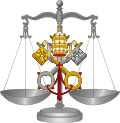Cleric regular
 |
| Part of a series on the |
| Canon law of the Catholic Church |
|---|
|
Catholicism portal |
Clerics regular or clerks regular are
Charism
Clerics regular are those bodies of men in the Church who while being essentially clerics, devoted to the exercise of the ministry in
In the
Clerics regular are distinguished from the purely monastic bodies, or monks, in four ways:
- They are primarily devoted to the sacred ministry; not so the monks, whose proper work is contemplation and the solemn celebration of the liturgy.
- They are obliged to cultivate the sacred sciences, which, if cultivated by the monks, are yet not imposed upon them by virtue of their state of life.
- Clerics regular as clerics must retain some appearance of clerical dress. This does not forbid orders of clerics regular to wear religious habits. It only requires that the habit of a cleric regular resemble clerical dress.
- Because of their occupations, they are less given to the practice of austerity which is a distinct feature of the purely monastic life.[1]
They are distinguished from the friars in this, that though the latter are devoted to the sacred ministry and the cultivation of learning, they are not primarily priests.
History
The exact date at which clerics regular appeared in the Church cannot be absolutely determined. Regular clerics of some sort, i.e. priests devoted both to the exercise of the ministry and to the practice of the religious life, are found in the earliest days of Christian antiquity. Many eminent theologians hold that the clerks regular were founded by Christ himself. In this opinion the Apostles were the first regular clerks, being constituted by Christ ministers par excellence of his Church and called by him personally to the practice of the counsels of the religious life (cf. Suarez).
From the fact that
It was not until the 16th century that clerics regular in the modern and strictest sense of the word came into being. Just as the conditions obtaining in the 13th century brought about a change in the monastic ideal, so in the sixteenth the altered circumstances of the times called for a fresh development of the religious spirit in the Church. This development, adapted to the needs of the times, was had in the various bodies of simple clerics, who, desirous of devoting themselves more perfectly to the exercise of their priestly ministry under the safeguards of the religious life, instituted the several bodies which, under the names of the various orders or regular clerics, constitute in themselves and in their imitators one of the most efficient instruments for good in the
The first order of cleric regular to be founded was the Congregation of Clerks Regular of the Divine Providence, better known as
Since the close of the 17th century, no new Orders have been added to the number, though the name Clerics Regular has been assumed occasionally by communities that are technically only religious, or pious,
See also
References
- ^ a b c Murphy, John F.X. "Clerks Regular." The Catholic Encyclopedia. Vol. 4. New York: Robert Appleton Company, 1908. 13 Jun. 2013.
- ^ Ragonesi, Franciscus. "Theatines." The Catholic Encyclopedia. Vol. 14. New York: Robert Appleton Company, 1912. 26 Dec. 2014.
- ^ ""About Us", The Barnabites". Archived from the original on 2015-02-06. Retrieved 2014-12-27.
- ^ Clerics Regular Minor.


